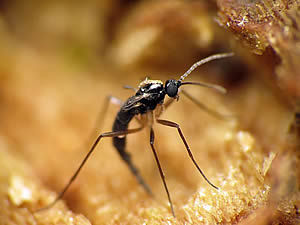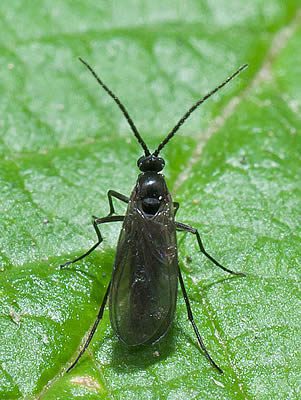When thinking about fungus gnats, the first idea that comes to mind is that we are dealing with a fungal disease or something similar. However, this seemingly harmless little mosquito is not a fungal disease, and can cause serious damage to your plants, especially young seedlings, and if you grow mushrooms, its effect can be devastating.

Fungus gnats, or sciarid flies as they are also known, get their name because their larvae feed on fungi present in the soil and organic matter. They belong primarily to the families Sciaridae, Keroplatidae, and Mycetophilidae. But for us gardeners, it’s important to be familiar with the gnats from the Sciaridae family. The larvae of these gnats are not content with feeding only on fungi; they also enjoy nourishing themselves from the roots and capillaries of our plants. In doing so, besides the direct damage itself, they still favor and inoculate plants with various fungi and bacteria (such as Pythium, Botrytis, Verticillium, Fusarium, Thielaviopsis, Cylindrocladium, and Sclerotinia) that can cause serious infections.

The adult gnat is tiny, about 2 to 4 mm (0.08 to 0.16 inches), has dark wings and long antennae, and flies in a somewhat clumsy manner. It lives for only about five days, just long enough for reproduction. They do not feed on the plants but spread their eggs around, carrying harmful fungi with them, contaminating soil and plants. Each fertilized female lays approximately 150 eggs. After 3 to 4 days, the larvae hatch. They have a transparent body, a black head, reach 5 to 12 mm (0.2 to 0.47 inches) in length, and their development lasts 14 days. As they move across the surface of the pot, they leave a slimy trail, as if a mini slug had passed by. When there are many, these trails can form a tangle.
Fungus gnats often go unnoticed. The gardener notices their plant wilting, but rarely blames the gnats, thinking instead that the plant became ill or someone cast an evil eye. They tend to appear when there is abundant organic matter and moisture, the same type of environment that fungi favor. Thus, certain types of plants end up being victimized more frequently than others. Cacti and succulents are rarely affected, but carnivorous plants, orchids, violets, and many other plants that enjoy moisture may end up being victims of these annoying gnats.
Prevention and control measures may include:

- Use well-cured and composted organic fertilizers. Do not place fruit peels or vegetable scraps on the soil. Likewise, never apply uncured manures to flower beds.
- Check if plants tolerate the soil drying out superficially between watering. Allowing the soil to dry out between waterings is quite effective in controlling gnats.
- Sterilize or pasteurize soil and substrates before making new plantings (30 minutes in a hot oven – all the soil must heat evenly, reaching 176 to 212°F (80 to 100°C));
- Manage irrigation to avoid excess water.
- Enhance light and ventilation among plants and pots (reduces fungi and disturbs the flight of gnats, as well as helps in drying out the substrate).
- Keep the environment and plants free of debris, such as dead leaves, flowers, and fruits, as they serve as a substrate for fungi and fungus gnats.
- Place inert covering over pots, such as sand, pebbles, perlite, plastic sheets, etc., discouraging the laying of eggs by adult insects.
- Keep carnivorous plants nearby, such as Droseras, Filiformis, Byblis, and Pinguicolas.
- In hydroponic cultivation, always keep equipment free of algae.
- Use yellow adhesive traps that help control and monitor the problem.
- Vinegar traps can be somewhat controversial, as while they kill the insects, they also attract them to the area, meaning you control the flies but continuously attract them.
- Sprinkle cinnamon on the surface of the pots. It has fungicidal action and controls the fungi that serve as food for the Fungus gnat.
Sprinkle diatomaceous earth (diatomite) on the surface of the pots. Contact and ingestion of the microparticles of silicon in this material cause dehydration and lesions in the insects’ digestive tract, thus acting as a non-poisonous insecticide. - Pyrethroid insecticides in aqueous solution applied to the substrate can be used with caution. Remember to wear gloves and protect yourself. Keep plants treated in this way out of reach of small children or pets, and never apply to vegetables, flowers, or fruits. Protect your health, the environment, and beneficial insects.
- Among the alternative options are Tobacco Broth with a drop of detergent and a solution of one part hydrogen peroxide (3% Hydrogen Peroxide) to four parts water (perform tests before applying to all your plants).
- In larger cultivations, we can use biological controls, such as the nematode Steinernema feltiae. This nematode likes the same type of environment as the gnat. It attacks both the larva and the pupa of the insect, providing control levels of up to 90%. Similarly, the predatory mite Stratiolaelaps scimitus can also be used to control the larvae of the fungus gnat.


